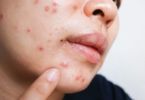Corn allergy can manifest itself in different ways. However, classic symptoms include vomiting, diarrhea, hives, and breathing difficulties. Do you want to know more about it? Continue reading!

Food allergies are a group of diseases that occur when the immune system reacts to proteins in certain foods. Specifically, the body recognizes these compounds as harmful and consequently begins to respond negatively. Have you heard about a corn allergy?
In some Central American countries, corn is a basic component to prepare different typical recipes, such as tacos, quesadillas, sopes, arepas, among others. It is also used in a wide variety of industrial products. However, in some people its consumption triggers a series of symptoms corresponding to an allergy.
How common is corn allergy?
To be more exact, a corn allergy develops when the body does not recognize a protein called zein. This triggers the release of histamine and other chemicals that claim to remove the substance. In turn, there are a series of clinical manifestations at the digestive, respiratory and cutaneous levels.
According to data from the American College of Allergy, Asthma and Immunology (ACAAI), allergy to corn is rare. Even so, it can be developed by repeated exposure to it, or by ingesting products derived from this grain, such as high fructose corn syrup, vegetable oil or cornstarch.
In certain cases it can occur due to cross-reactivity between corn and other allergenic components that are present in cereals such as wheat or soy products. Diagnosis can be difficult, as symptoms tend to resemble those of a pollen allergy.

Corn allergy is not very common. Still it can cause digestive, respiratory and skin difficulties in sensitive people.
Symptoms of corn allergy
As a consequence of chemical reactions that occur in the body, a corn allergy triggers a number of common symptoms. Often they appear in a matter of minutes; however, they sometimes take up to 2 hours or more to manifest. The most frequent are the following:
Vomiting
Abdominal pain and stomach cramps.
Indigestion and a feeling of constant fullness.
Diarrhea.
Wheezing (sounds that resemble wheezing when breathing).
Difficulty breathing and a feeling of tightness in the chest.
Urticaria (itchy skin rash).
Swelling in the face
Dizziness
Confusion.
Pale or blue discoloration of the skin.
Repetitive cough
Throat tightness and hoarse voice.
Decreased pulse.
In some cases, a serious condition, known as anaphylaxis, can occur. This includes symptoms that can be life-threatening, such as the following:
Abrupt swelling of the face with narrowing of the lips, throat, tongue and neck.
Difficult breathing
Confusion and lightheadedness.
Elevated heart rate
Loss of consciousness.
Fatigue.
Your timely attention is essential to avoid a fatal outcome. Therefore, it is essential to seek medical attention as soon as they occur.
How do you make the diagnostic?
To determine if a person is allergic to corn, it is necessary to carry out a diagnostic test, especially since the symptoms are diverse and can vary in each one. It may even happen that the symptoms are not always the same in each reaction.
So, if there is a suspicion of this type of allergy, it is best to make an appointment with a doctor or nutritionist. The professional can ask the following questions:
What and how much did she eat?
What were the symptoms that appeared? How long did it take?
How were they alleviated?
How long did it take to get better?
Corn allergy treatment
Mild allergic reactions do not require specific treatment. You simply have to watch them until they pass. On the contrary, if there are anaphylactic reactions, seek emergency medical attention and use epinephrine.
Changes in eating habits
Due to all the effects that the consumption of corn can trigger in allergy sufferers, the best way to avoid its adverse effects is to stop consuming this product. In this sense, it is necessary to learn to recognize which are the sources of corn that are hidden in food.
It is advisable to go to a nutrition professional to help identify the ingredients that are derived from this grain. According to the Spanish Association of People with Food and Latex Allergy, some products that contain it are the following:
Sauces
Snacks
Canned fruits
Prepared meats, such as hot dogs and cold cuts.
Beverages sweetened with corn sugars.
Cornmeal.
Cornstarch.
Popcorn.
Semolina.
Margarine.
Corn chips.
Cornflakes.

Corn is present in many industrial products. Therefore, in addition to avoiding it in its natural form, it must be identified in the products of habitual consumption.
Of course, as with any food allergy, it is necessary to modify eating habits to avoid major problems. So, it is convenient to know which are the options that do not contain this ingredient. For example, the following foods:
Wheat flour.
Wheat-based pasta.
Eggs.
Red and white meats.
Quinoa
Locally produced honey.
Vegetables.
Natural yogurt.
Chocolate chips.
Rice.
100% fruit juices.
Nuts like peanuts, almonds, and walnuts.
Oatmeal.
Cocoa.
Raw cheese
Rice or wheat breads.
Corn-based non-food products
Careful! Beyond the foods that contain corn, there are a series of products of regular use that can have this ingredient in their composition. It is important to recognize them in case of allergy, as they are also harmful. Some of them are mentioned below:
Shampoo.
Toothpaste.
Cosmetics.
Painting.
Plastics
Dishwashing liquid.
Pet food.
Surgical gloves (due to cornstarch).
Food wrappers (cornstarch coatings).
It should be noted that the damage caused by these products can be variable since they are not ingested.
What to remember about a corn allergy?
Corn-based products are very common on the market. Although it is not very frequent, its habitual consumption can cause allergies in sensitive people. If so, it is essential to avoid its consumption and consult your doctor or nutritionist.
Professionals will be able to make a diagnosis based on the clinical manifestations of the allergy. Likewise, they will guide the best diet to avoid complications or nutrient deficiencies. Fortunately, it is possible to eat a healthy and balanced diet without the need to eat corn or its derivatives.





